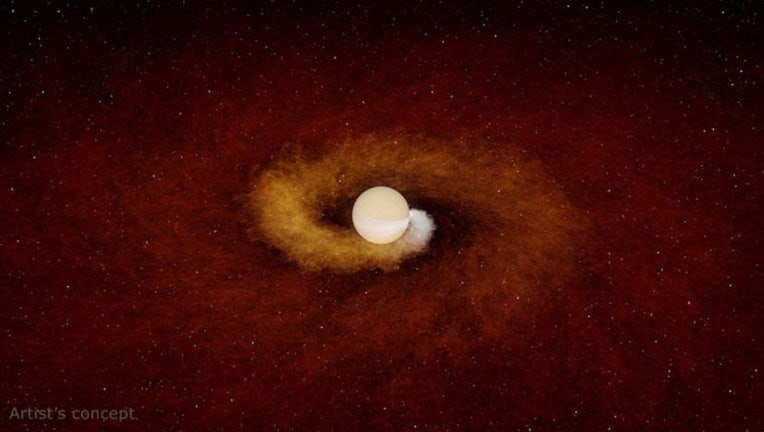Scientists discover star devouring planet for first time and think Earth could suffer same fate

This artist’s concept shows a planet gradually spiraling into its host star. The Jupiter-size planet pulls gas away from the star, sending it into space. (R. Hurt & K. Miller (Caltech/IPAC) / NASA)
For the first time, scientists say they’ve discovered a star that was nearing the end of its life swell up and absorb a Jupiter-sized planet and think the same thing could one day happen to the sun and Earth.
But don’t worry – we’ve got about 5 billion years to prepare.
The out-of-this-world discovery was documented in the journal Nature on Wednesday.
According to NASA’s Jet Propulsion Laboratory, the star began to grow in size after running out of fuel, which decreased the distance between it and the neighboring planet, eventually consuming it entirely.
The JPL said our sun would also go through a similar aging process and possibly grow to 100 times its current diameter to become what’s known as a red giant.
When that happens, the JPL believes it will absorb Mercury, Venus – and possibly Earth.
According to the JPL, astronomers have identified many red giant stars and believe that some had consumed nearby planets but were never observed.
"This type of event has been predicted for decades, but until now, we have never actually observed how this process plays out," said Kishalay De, an astronomer at the Massachusetts Institute of Technology in Cambridge and the study’s lead author.
FLOWER MOON 2023: WHEN TO SEE THE BRIGHTEST FULL MOON IN MAY
The planet-eating event, officially called ZTF SLRN-2020, was observed using multiple ground-based observations and NASA’s Near-Earth Object Wide Field Infrared Survey Explorer (NEOWISE), which the JPL manages.
Scientists say the planet was likely the size of Jupiter and had an orbit around its star even closer than Mercury around the sun.
In a news release, JPL said this event is only starting the final phases of its life and can last up to 100,000 years.
ETA AQUARID METEOR SHOWER 2023: HOW AND WHEN TO SEE THE PEAK
Like a meteor burning up in Earth’s atmosphere
As the star grew in size, the outer atmosphere surrounded the planet, and it began to slow down the orbit and eventually was pulled below the star’s visible surface, like a meteor burning up in the Earth’s atmosphere, the JPL said.
That energy transfer then caused the start to briefly increase in size and become a few hundred times brighter before returning to the size and brightness observed before the event.
According to the JPL, that initial brightness showed up in observations by the Caltech-led Zwicky Transient Facility (ZTF), which watches for cosmic events that change in brightness quickly, some in a matter of hours.
De had been using the ZTF while researching something else when he noticed the flash and had never seen it before.
He then used the NEOWISE observatory, which scans the sky with infrared light every six months.
When De looked over the data, he saw that the star had gotten brighter almost one year before ZTF spotted the flash of light.
LOOK OUT FOR THESE ASTRONOMICAL EVENTS IN MAY
According to the JPL, that was evidence of dust forming around the star.
De and his colleagues said they believed the dust indicated that the planet pulled in gasses from the star while it was being devoured.
More gas was then thrown into space and was observed by ground-based observatories and NEOWISE.
Earth’s demise won’t be as spectacular
When the sun becomes a red giant in about 5 billion years, researchers believe the same event will gobble up Mercury, Venus and Earth, but won’t be as spectacular, according to De, because they aren’t as large as the one that was just swallowed up.
"If I were an observer looking at the solar system 5 billion years from now, I might see the sun brighten a little, but nothing as dramatic as this, even though it will be the exact same physics at work," he said.

